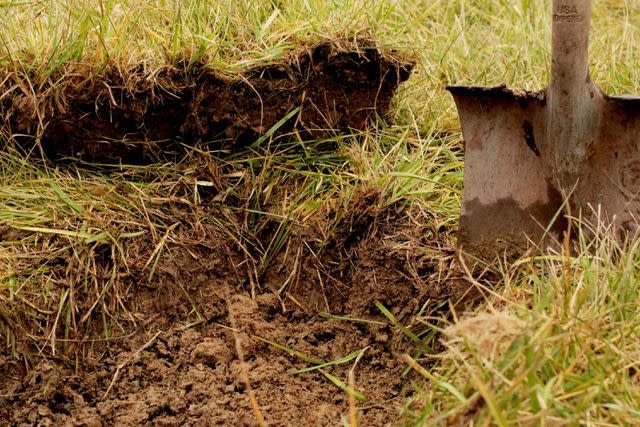How to Remove Grass the Right Way When You're Getting Rid of a Lawn
:max_bytes(150000):strip_icc():format(jpeg)/newspaper-mulch-kill-grass-big-56a583073df78cf77288ab15.jpg)
If you are considering removing your lawn, it's best to know how to remove grass most effectively. There are a few reasons you might be looking to get rid of a lawn, like less landscape maintenance or replacing the lawn with a garden.
The method you choose to remove grass makes all the difference—it can ensure this is a fun project involving little hard work rather than a back-breaking one that leaves you wondering if you should have left your lawn in place.
Ahead, learn why you might want to get rid of your lawn, how best to remove the grass, and what to do after the job is finished.
Reasons to Remove a Lawn
There are several reasons why you might remove a lawn or portions of it. You might be looking to save water, reduce landscape maintenance, or grow more interesting plants, instead.
To keep a lawn lush and green requires a lot of water and work. By removing grass, you can instead install a hardscape, such as a brick patio, plant the area with drought-resistant plants, or cover the area with gravel
You could also want to forgo plain grass and use your space as a garden, whether a vegetable garden, perennial or annual bed, or shrub planting.
Want more gardening tips? Sign up for our free gardening newsletter for our best-growing tips, troubleshooting hacks, and more!
How to Remove a Lawn the Easiest Way

The Spruce / Steven Merkel
The easiest way to remove grass is to smother it, as long as you're patient.
Mow the grass first, then lay down a smothering agent, such as black plastic (tarps also work here) or newspaper.
To hold down the plastic, place bricks along the perimeter.
To keep the newspaper from blowing away, cover it with 6 inches of mulch. An attractive type of mulch such as bark mulch will also keep the neighbors happier for the duration of your project.
Once deprived of sun, water, and nutrients, almost everything underneath will eventually die.
Using Herbicide to Remove Grass
Applying a chemical herbicide is another easy way to remove grass. Another pro of this method is that it's quick, but chemical herbicides are toxic substances. This fact will be especially concerning if you have pets and/or children who will be making frequent use of the area.
If you do use an herbicide, take the necessary safety precautions (wearing gloves, goggles, etc.).
Using Solarization to Remove Grass
This method employs clear plastic rather than black plastic. Moisten the grass before applying the plastic. This creates a "greenhouse" so that what's beneath it will be heated up until it's dead.
Unlike using herbicide, it's a safe method for removing grass, but it has some cons. It requires long sunny periods to be most effective, so you're dependent on the weather. Similarly to smothering, it's a relatively slow method, too.
Digging Out Your Lawn

The Spruce / Steven Merkel
Along with using herbicides, this method is a course of last resort. It is quite labor-intensive, especially if you must use hand tools (a shovel or, better, a spade). It can also be hard on your back, so be sure to wear a back brace if you are digging out the grass using a spade.
If you are committed to using a method that involves digging, try to use power tools instead. A sod-cutter is one option. Even better is a rototiller, since it allows you to cut down deeper into the soil, digging out all of the roots so that the grass is less likely to come back. B
oth of these power tools can rented from your local rental center. One pro of this method is that, like using an herbicide, it's fast.
The Raised-Bed Workaround
To carve a small space out of the lawn for use as a garden, your best bet is to build a raised bed. You won't have to worry about removing the grass: The raised bed, itself will smother it. Simply fill the bed with good soil, ensure drainage, and begin planting immediately.
What to Do After Removing Your Lawn
If you've planned on replacing the grass with a hardscape, establish a suitable base. For example, if you decide to lay gravel down, install landscape fabric before you apply the gravel. A landscape fabric base will prevent weeds from popping up through your gravel over time, keeping the area low-maintenance.
Building up the soil is important after removing grass so your new plants will flourish. Using compost is a great way to improve soil fertility and friability, as well as its ability to drain well yet retain sufficient moisture. If your yard needs extra drainage help, install a French drain.
Many plants perform poorly without good drainage; some will die without it. You should also have your soil tested to check its pH level. After many years of neglect, some soils will become too acidic for certain plants to thrive in them.
After you've built up the soil, decide on a garden design. Garden design has both aesthetic and practical aspects. If you have removed part of the lawn for gardening but have left the rest intact, install edging to keep the grass from invading your plantings.
Frequently Asked Questions
What is the easiest way to remove grass?
Smothering is the easiest method. Its main drawback is that you have to wait a while for it to work.
What is the best tool to remove unwanted grass?
If you're digging the grass out, the best tool is a power tool such as a rototiller or a sod-cutter.
How do you remove grass and replace it with gravel?
After you've removed the grass by digging, smothering, etc., lay down landscape fabric, then apply the gravel.
Read the original article on The Spruce.

